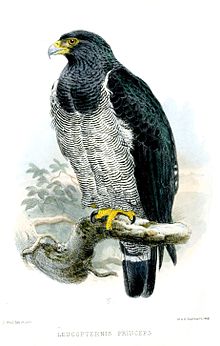Barred Hawk
| Barred Hawk | |
|---|---|
 | |
| Conservation status | |
| Scientific classification | |
| Kingdom: | Animalia |
| Phylum: | Chordata |
| Class: | Aves |
| Order: | Falconiformes |
| Family: | Accipitridae |
| Genus: | Leucopternis |
| Species: | L. princeps |
| Binomial name | |
| Leucopternis princeps Sclater, 1865 | |
The Barred Hawk (Leucopternis princeps) is a species of bird of prey in the Accipitridae family. It has also been known as the Black-chested Hawk.
It is found in Colombia, Costa Rica, Ecuador, Panama, and Peru. Its natural habitats are subtropical or tropical moist lowland forests and subtropical or tropical moist montane forests. 10,000 to 100,000 barred hawks are thought to exist throughout Central and South America. Barred Hawk’s are the largest of the Leucopternis genus and mainly live in the dense forests of the lowland and mountainous areas. The characteristic plumage of black barred and white belly is unique to the forests hawk of Leucopternis.
Taxonomy and Evolution
Phillip L. Schlater first classified the Barred Hawk in 1865. Barred Hawks are in the familyAccipitridae that contains all the hawks, eagles, and old world vultures The genus, Leucopternis, means Neotropical (biogeographic region of the new world that stretches southward from the Tropic of Cancer and includes Mexico, Central and South America, and the West Indies ) hawk. Recent research-using mtDNA to analyze the phylogeny of this genus has been done. What researchers found was that the black and white plumage of genus Leucopternis has evolved at least twice, and the widespread occurrence of this plumage pattern may result from plumage convergence in forested. In classical taxonomy, the black and white plumage pattern was overemphasized in the grouping of Leucopternis and plumage patterns alone may not be reliable taxonomic markers in this family.
Physical Characteristics
L. princeps is the largest of the genus appearing black with a single white tail bar from above. The black barred and white belly and under-wing coverts contrast with the black throat, breast, and wing quills.Barred Hawks have a snout-like bill that makes them look like they have a heavy head. Members of the genus are smaller than most old world hawks, which allow them to maneuver through the thick forest canopy easier. The female Barred Hawk, showing sexual dimorphism, is larger than the males. L. princeps weigh about 1 kg and have a 364-367mm wingspan in males and a 380–388 mm wingspan in females. They have very broad wings and short tail: wingspan is 2.2 times total length of the bird. The body of a Barred Hawk is dark grey with a white chest. On the chest are uniformly spaced black bars, which is where the hawk gets its name. The white and black plumage is common among genus Leucopternis and is unique of the forest hawks of the Neotropics.
The calls of L. princeps include high-pitched screaming or whistling, hoarse “whees”, “yips”, “dits”, and ”weeps. Barred Hawks are usually noisy when soaring in the sky.
Distribution and habitat
This species of hawk has a large Extent of Occurrence of 350,000 km2. The Barred Hawks is primarily a Caribbean species of the middle altitudes,and are found in Costa Rica, Peru, and Panama and on both sides of the Andes in northern Ecuador and western Columbia. Subtropical or tropical lowland and mountain forests are the natural habitat of the Barred Hawk. They live between 300 and 2,500 meters in elevation and are most abundant in the 900–1600 m elevation range.
Behavior
L. princeps hunts mostly in the canopy and along mountain forests. The hunting technique of barred hawks contains both active and inactive activities. The hawks can be seen silently sitting on a branch looking for prey or habitually soaring noisily in the sky in a group of two or more.Barred Hawks rarely leave the forest region to hunt but may hunt along the edges. They swiftly and quietly fly from branch to branch, when hunting within the forest. When perching they are usually at a mid to low height off the ground and are often on the hunt for slow prey such as frogs, snakes, small mammals and birds, and large insects.

No comments:
Post a Comment